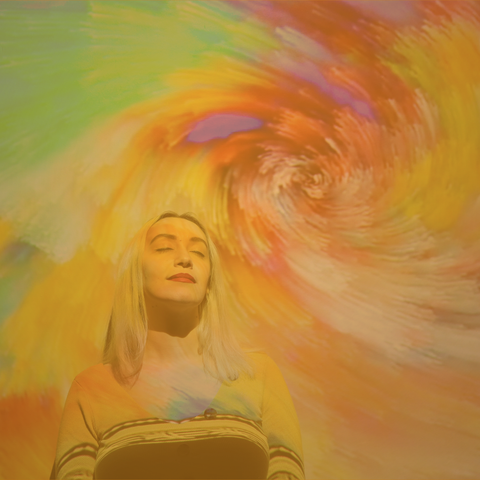
The application of psychedelic therapies, using substances such as LSD, psilocybin, ketamine, or MDMA, is being studied for mental health purposes [1]. Melatonin is a hormone produced in the pineal gland that signals darkness and promotes sleep. It also serves as a potent antioxidant and modulator of brain function [2].
People may wonder if taking melatonin (sometimes called the “sleep hormone”) matters for such psychedelic treatments.
In this article, we will look at what’s known about combining melatonin with common psychedelics, based on the current evidence available. We discuss how melatonin might enhance, dampen, or otherwise alter psychedelic effects, how it could influence sleep and neuroplasticity, and what gaps remain in the research base.
How does melatonin work in the brain?
Melatonin acts on MT1/2 receptors to synchronize the sleep-wake cycle, bringing on drowsiness at night [3,4]. It has many other roles, comprising neuroprotective [5] and anti-inflammatory effects, and can boost antioxidants and even influence mood and brain development [6,7]. If you want a deeper dive, check out our dedicated blog here, or if you're looking for a sleep solution with low-dose melatonin, check out Tro Zzz.
In animals, melatonin stimulates the formation of new neurons, protects neurons from stress, and enhances neuroplasticity in the central nervous system [8].
People take melatonin for jet lag or insomnia as it typically shortens sleep latency and enhances rapid eye movement (REM) sleep duration [9-12]. However, higher melatonin doses are known to cause common side effects like drowsiness, headaches, or vivid dreams. Many users report more intense dreams or nightmares on melatonin, although evidence is mixed [12-15].
Classical psychedelics and melatonin: LSD and psilocybin
Psychedelics like LSD and psilocybin mainly activate serotonin 5-HT2A receptors, which induce altered perception and oftentimes “mystical experiences” [16-18].
They also have unique endocrine effects on the pineal gland (which produces melatonin). Animal studies show that LSD, as well as related compounds (mescaline and psilocin), can stimulate melatonin release from the pineal gland [19].
No direct human trials have been conducted on the provision of melatonin before or during the administration of these classic psychedelics, as the research is in its infancy. Clues from rodent studies point to melatonin likely mellowing the experience. Post-session melatonin use could help those struggling to sleep, as many experiences last between 6-12 hours, and melatonin could help ease a racing mind.
MDMA and melatonin
MDMA (known as “ecstasy”) is an entactogen that strongly releases serotonin, dopamine, and norepinephrine. Its acute effects (e.g., feelings of warmth, increased energy, euphoria) are quite different from classic psychedelics, but it also often disrupts sleep afterwards [20].
Chronic MDMA use can deplete serotonin terminals [21], leading to long-term sleep/circadian problems and mood issues. Tellingly, melatonin is made from serotonin, so heavy MDMA use might indirectly reduce melatonin levels.
Preliminary trials for post-traumatic stress disorder have found that MDMA can improve sleep quality in patients over the long term [22].
Ketamine and melatonin
Ketamine is an NMDA-receptor antagonist used in anesthesia and increasingly as a rapid-acting antidepressant. It also alters consciousness, though usually for a much shorter duration of around 1-2 hours during IV infusions.
Some preclinical evidence exists for the synergy between ketamine and melatonin. Two recent studies found that melatonin can enhance the neurogenic and antidepressant effects of ketamine, and the combination worked faster than standard antidepressants [23,24].
Effects on neuroplasticity and therapy outcomes
One reason to consider the role of melatonin in psychedelic therapy is its impact on neuroplasticity. Psychedelic therapy often aims to rewire thought patterns and strengthen healthy neural circuits. Many psychedelics are known to increase BDNF and neurogenesis in the brain, contributing to long-lasting improvements in mood.
Melatonin independently boosts plasticity. It stimulates neuronal growth in the hippocampus and improves the survival of new neurons. For example, chronic melatonin treatment in rodents increases BDNF-related signaling and enhances synaptic connectivity. It also counters glutamate excitotoxicity, which can otherwise damage neurons. Therefore, melatonin might enhance psychedelics by providing a protective, pro-plasticity environment. If a psychedelic drug opens a “window” of brain flexibility, melatonin might help stabilize new connections formed during that window.
Moreover, both sleep and circadian regulation profoundly affect plasticity and mood. Poor sleep can hinder learning and emotional processing, whereas good-quality sleep (especially deep and REM sleep) consolidates memories and emotional insights. Psychedelic experiences often stir up strong emotions and insights that require integration during subsequent sleep. As melatonin reliably promotes deeper, earlier sleep, it could support the consolidation of the psychedelic experience. Conversely, if melatonin causes unusually vivid dreams, it may keep the brain in a heightened state of dreaming, which could either reinforce the session’s themes or, if unpleasant, make processing more difficult for the individual.
Conclusion
Melatonin has many intriguing properties. It calms the body, shifts circadian rhythms, and promotes neuroplasticity. These attributes overlap with therapeutic needs in psychedelic treatment, for instance, the consolidation of insights, emotional processing during sleep, and neural rewiring.
Preclinical studies show melatonin can enhance the effects of ketamine, a popular psychedelic medicine, suggesting potential synergy. Conversely, melatonin physiologically opposes classical psychedelics, hinting that it could mute or shape those experiences.
Whether this is helpful or detrimental depends on context. Right now, melatonin’s role in psychedelic therapy is largely speculative. Any use should be individualized and cautiously supervised by appropriate personnel.
References
[1] C.M. Reiff, E.E. Richman, C.B. Nemeroff, L.L. Carpenter, A.S. Widge, C.I. Rodriguez, N.H. Kalin, W.M. McDonald, and the Work Group on Biomarkers and Novel Treatments, a Division of the American Psychiatric Association Council of Research, Psychedelics and Psychedelic-Assisted Psychotherapy, AJP 177 (2020) 391–410. https://doi.org/10.1176/appi.ajp.2019.19010035.
[2] S.B. Ahmad, A. Ali, M. Bilal, S.M. Rashid, A.B. Wani, R.R. Bhat, M.U. Rehman, Melatonin and Health: Insights of Melatonin Action, Biological Functions, and Associated Disorders, Cell Mol Neurobiol 43 (2023) 2437–2458. https://doi.org/10.1007/s10571-023-01324-w.
[3] J. Liu, S.J. Clough, A.J. Hutchinson, E.B. Adamah-Biassi, M. Popovska-Gorevski, M.L. Dubocovich, MT1 and MT2 Melatonin Receptors: A Therapeutic Perspective, Annu. Rev. Pharmacol. Toxicol. 56 (2016) 361–383. https://doi.org/10.1146/annurev-pharmtox-010814-124742.
[4] G. Gobbi, S. Comai, Differential Function of Melatonin MT1 and MT2 Receptors in REM and NREM Sleep, Front. Endocrinol. 10 (2019) 87. https://doi.org/10.3389/fendo.2019.00087.
[5] J.G. Lee, Y.S. Woo, S.W. Park, D.-H. Seog, M.K. Seo, W.-M. Bahk, The Neuroprotective Effects of Melatonin: Possible Role in the Pathophysiology of Neuropsychiatric Disease, Brain Sciences 9 (2019) 285. https://doi.org/10.3390/brainsci9100285.
[6] L. Sagrillo-Fagundes, E. Maria Assuncao Salustiano, P. Wong Yen, A. Soliman, C. Vaillancourt, Melatonin in Pregnancy: Effects on Brain Development and CNS Programming Disorders, CPD 22 (2016) 978–986. https://doi.org/10.2174/1381612822666151214104624.
[7] V. Srinivasan, M. Smits, W. Spence, A.D. Lowe, L. Kayumov, S.R. Pandi-Perumal, B. Parry, D.P. Cardinali, Melatonin in mood disorders, The World Journal of Biological Psychiatry 7 (2006) 138–151. https://doi.org/10.1080/15622970600571822.
[8] M. Valdés‐Tovar, R. Estrada‐Reyes, H. Solís‐Chagoyán, J. Argueta, A.M. Dorantes‐Barrón, D. Quero‐Chávez, R. Cruz‐Garduño, M.G. Cercós, C. Trueta, J. Oikawa‐Sala, M.L. Dubocovich, G. Benítez‐King, Circadian modulation of neuroplasticity by melatonin: a target in the treatment of depression, British J Pharmacology 175 (2018) 3200–3208. https://doi.org/10.1111/bph.14197.
[9] D. Kunz, R. Mahlberg, C. Müller, A. Tilmann, F. Bes, Melatonin in Patients with Reduced REM Sleep Duration: Two Randomized Controlled Trials, The Journal of Clinical Endocrinology & Metabolism 89 (2004) 128–134. https://doi.org/10.1210/jc.2002-021057.
[10] I.R. McGrane, J.G. Leung, E.K. St. Louis, B.F. Boeve, Melatonin therapy for REM sleep behavior disorder: a critical review of evidence, Sleep Medicine 16 (2015) 19–26. https://doi.org/10.1016/j.sleep.2014.09.011.
[11] R.F.N. Ribeiro, M.R. Santos, M. Aquino, L.P. De Almeida, C. Cavadas, M.M.C. Silva, The Therapeutic Potential of Melatonin and Its Novel Synthetic Analogs in Circadian Rhythm Sleep Disorders, Inflammation‐Associated Pathologies, and Neurodegenerative Diseases, Medicinal Research Reviews 45 (2025) 1515–1539. https://doi.org/10.1002/med.22117.
[12] F.M.C. Besag, M.J. Vasey, K.S.J. Lao, I.C.K. Wong, Adverse Events Associated with Melatonin for the Treatment of Primary or Secondary Sleep Disorders: A Systematic Review, CNS Drugs 33 (2019) 1167–1186. https://doi.org/10.1007/s40263-019-00680-w.
[13] L.P.H. Andersen, I. Gögenur, J. Rosenberg, R.J. Reiter, The Safety of Melatonin in Humans, Clin Drug Investig 36 (2016) 169–175. https://doi.org/10.1007/s40261-015-0368-5.
[14] K.B. Van Der Heijden, M.G. Smits, E.J.W. Van Someren, K.R. Ridderinkhof, W.B. Gunning, Effect of Melatonin on Sleep, Behavior, and Cognition in ADHD and Chronic Sleep-Onset Insomnia, Journal of the American Academy of Child & Adolescent Psychiatry 46 (2007) 233–241. https://doi.org/10.1097/01.chi.0000246055.76167.0d.
[15] N. Buscemi, B. Vandermeer, N. Hooton, R. Pandya, L. Tjosvold, L. Hartling, G. Baker, T.P. Klassen, S. Vohra, The efficacy and safety of exogenous melatonin for primary sleep disorders a meta-analysis, J Gen Intern Med 20 (2005) 1151–1158. https://doi.org/10.1111/j.1525-1497.2005.0243.x.
[16] R. Griffiths, W. Richards, M. Johnson, U. McCann, R. Jesse, Mystical-type experiences occasioned by psilocybin mediate the attribution of personal meaning and spiritual significance 14 months later, J Psychopharmacol 22 (2008) 621–632. https://doi.org/10.1177/0269881108094300.
[17] I. Wießner, M. Falchi, F. Palhano-Fontes, A. Feilding, S. Ribeiro, L.F. Tófoli, LSD, madness and healing: Mystical experiences as possible link between psychosis model and therapy model, Psychol. Med. 53 (2023) 1151–1165. https://doi.org/10.1017/S0033291721002531.
[18] F.S. Barrett, R.R. Griffiths, Classic Hallucinogens and Mystical Experiences: Phenomenology and Neural Correlates, in: A.L. Halberstadt, F.X. Vollenweider, D.E. Nichols (Eds.), Behavioral Neurobiology of Psychedelic Drugs, Springer Berlin Heidelberg, Berlin, Heidelberg, 2017: pp. 393–430. https://doi.org/10.1007/7854_2017_474.
[19] V.P. Acero, E.S. Cribas, K.D. Browne, O. Rivellini, J.C. Burrell, J.C. O’Donnell, S. Das, D.K. Cullen, Bedside to bench: the outlook for psychedelic research, Front. Pharmacol. 14 (2023) 1240295. https://doi.org/10.3389/fphar.2023.1240295.
[20] S. Randall, C.-E. Johanson, M. Tancer, T. Roehrs, Effects of Acute 3, 4-Methylenedioxymethamphetamine on Sleep and Daytime Sleepiness in MDMA Users: A Preliminary Study, Sleep 32 (2009) 1513–1519. https://doi.org/10.1093/sleep/32.11.1513.
[21] E. Kirilly, E. Molnar, B. Balogh, S. Kantor, S.R. Hansson, M. Palkovits, G. Bagdy, Decrease in REM latency and changes in sleep quality parallel serotonergic damage and recovery after MDMA: a longitudinal study over 180 days, Int. J. Neuropsychopharm. 11 (2008). https://doi.org/10.1017/S1461145708008535.
[22] L. Ponte, L. Jerome, S. Hamilton, M.C. Mithoefer, B.B. Yazar‐Klosinski, E. Vermetten, A.A. Feduccia, Sleep Quality Improvements After MDMA‐Assisted Psychotherapy for the Treatment of Posttraumatic Stress Disorder, Journal of Traumatic Stress 34 (2021) 851–863. https://doi.org/10.1002/jts.22696.
[23] R. Estrada-Reyes, D.B. Quero-Chávez, C. Trueta, A. Miranda, M. Valdés-Tovar, S. Alarcón-Elizalde, J. Oikawa-Sala, J. Argueta, L.A. Constantino-Jonapa, J. Muñoz-Estrada, M.L. Dubocovich, G. Benítez-King, Low Doses of Ketamine and Melatonin in Combination Produce Additive Antidepressant-like Effects in Mice, IJMS 22 (2021) 9225. https://doi.org/10.3390/ijms22179225.
[24] R. Estrada-Reyes, D.B. Quero-Chávez, S. Alarcón-Elizalde, M.G. Cercós, C. Trueta, L.A. Constantino-Jonapa, J. Oikawa-Sala, J. Argueta, R. Cruz-Garduño, M.L. Dubocovich, G.A. Benítez-King, Antidepressant Low Doses of Ketamine and Melatonin in Combination Produce Additive Neurogenesis in Human Olfactory Neuronal Precursors, Molecules 27 (2022) 5650. https://doi.org/10.3390/molecules27175650.





Comments (0)
There are no comments for this article. Be the first one to leave a message!